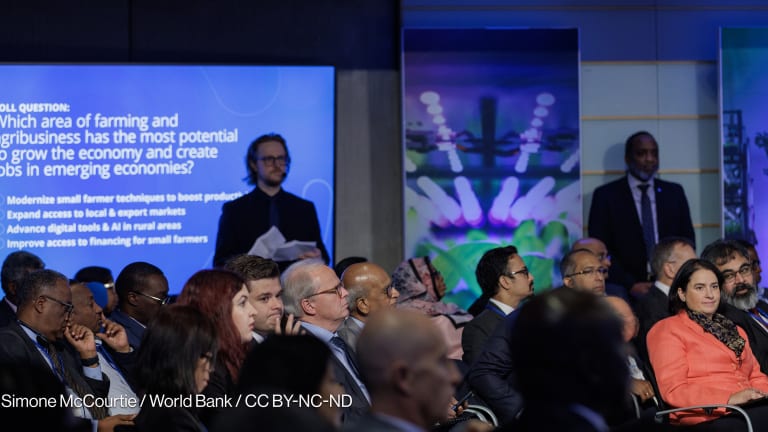World Bank-Nepal Partnership
Weak infrastructure, particularly in the energy and transportation sectors, is the largest impediment to sustainable and inclusive growth in Nepal — a problem the World Bank aims to help address through its latest partnership strategy.
Village road in Nepal. Weak infrastructure, particularly in the energy and transportation sectors, is the largest impediment to sustainable and inclusive growth in Nepal. Photo by: Simone D. McCourtie / World Bank / CC BY-NC-ND For the past two decades, Nepal has had relatively stable but modest economic growth, averaging at 4 percent since the mid-1990s. Even so, the South Asian country managed to reduce extreme poverty from 53 percent in 2004 to just 25 percent in 2011. Yet most of its success on the economic front can be attributed mainly to labor migration and the influx of remittances. Nepal still ranks among the poorest nations in the world, placing 157th out of 187 countries in the Human Development Index. With a growing population, limited employment opportunities and an undiversified economy, the country has yet to achieve sustainable, inclusive development. The World Bank has identified weak infrastructure, particularly in the energy and transportation sectors, as the largest impediment to growth. Despite massive potential for hydropower production, Nepal continues to resort to load shedding, which lasts up to 18 hours a day, greatly impeding the country’s productivity. Meanwhile, poor road conditions leave Nepalese communities isolated from local and regional markets as well as limit the population’s access to basic social services. Following its recently concluded interim strategy program with Kathmandu, the World Bank has released a new long-term country partnership strategy for Nepal. The four-year plan outlines the bank’s primary objectives and approach to delivering aid to the country over the funding period covering fiscal years 2014–2018. Funding levels World Bank assistance to Nepal will mainly involve contributions from the International Development Association, International Finance Corp. and trust funds. The active IDA portfolio in Nepal amounts to roughly $1.69 billion, which covers 17 national and three regional projects. As of January 2014, $648 million of this amount had already been disbursed. Trust fund allocations amounting to $225 million currently support IDA-funded activities. Meanwhile, IFC commitments have already reached $40 million as of March 2014. Below is a breakdown of IDA, IFC and trust fund annual commitments in recent years. Funding priorities World Bank assistance has two main objectives: - Increase economic growth and competitiveness. - Increase inclusive growth and opportunities for shared prosperity. In Nepal, the bank’s strategy to strengthen the economy will involve developing hydropower resources to stabilize the country’s energy supply. This will allow existing businesses and service providers to operate better while creating a more viable trading environment for investors. Increasing Nepal’s power output can also open up opportunities for exporting energy to neighboring countries. The transportation sector will likewise be targeted to ease access to markets both locally and in India. Private sector support will also be prioritized. To boost inclusiveness, the World Bank will help develop Nepal’s agriculture sector and scale up basic social services. In agriculture, the bank will encourage agricultural households to start producing high-value crops to increase their income; low-value crops still account for 80 percent of output. In the health sector, support will be targeted at increasing the availability of health and nutrition services to marginalized groups. The bank also intends to develop the Nepalese workforce by broadening access to education while elevating the quality and relevance of available courses. Further, social safety net systems will be improved by heightening their transparency and efficiency. For fiscal 2014-2018, planned IDA and trust fund activities include the following: Devex analysis The World Bank, through the IDA, has consistently been a top donor to Nepal, along with the United Kingdom, Asian Development Bank and United States. To increase the impact of its aid, the bank has started to streamline its focus sectors, opting to concentrate on areas where it has a comparative advantage over its development partners. Specifically, the World Bank will continue to be heavily involved in areas of energy, transportation, finance, agriculture, skills development and health. To a lesser extent, the bank will also support aid efforts of its development partners in the areas of primary education, peace and reconstruction, and urban, local and social development. Nepal is still considered a high-risk state. Since ending its decadelong civil war in 2006, the country has struggled to establish stability within its government. This has not only impeded the country’s development, it has affected donors’ aid delivery as well. The fragmented government has multiple factions that each work toward its own agenda, making it difficult to develop institutions that can deliver much-needed social services effectively. Corruption remains widespread, and distrust in the government has weakened rule of law, increasing the propensity for social unrest. To temper these risks, the bank intends to continue working with the Nepalese government throughout this funding period, especially in areas of public finance management, capacity building and policy support. In contrast to previous engagements with Nepal, the World Bank’s new partnership strategy has shifted from short-term, post-conflict assistance to a long-term development approach. Contact World Bank Kathmandu Office Tel: (977-1) 4220-6792 Email:
Village road in Nepal. Weak infrastructure, particularly in the energy and transportation sectors, is the largest impediment to sustainable and inclusive growth in Nepal. Photo by: Simone D. McCourtie / World Bank / CC BY-NC-ND
For the past two decades, Nepal has had relatively stable but modest economic growth, averaging at 4 percent since the mid-1990s. Even so, the South Asian country managed to reduce extreme poverty from 53 percent in 2004 to just 25 percent in 2011.
Yet most of its success on the economic front can be attributed mainly to labor migration and the influx of remittances. Nepal still ranks among the poorest nations in the world, placing 157th out of 187 countries in the Human Development Index. With a growing population, limited employment opportunities and an undiversified economy, the country has yet to achieve sustainable, inclusive development.
This story is forDevex Promembers
Unlock this story now with a 15-day free trial of Devex Pro.
With a Devex Pro subscription you'll get access to deeper analysis and exclusive insights from our reporters and analysts.
Start my free trialRequest a group subscription Printing articles to share with others is a breach of our terms and conditions and copyright policy. Please use the sharing options on the left side of the article. Devex Pro members may share up to 10 articles per month using the Pro share tool ( ).
As former Devex editor for business insight, Aimee created and managed multimedia content and cutting-edge analysis for executives in international development.








